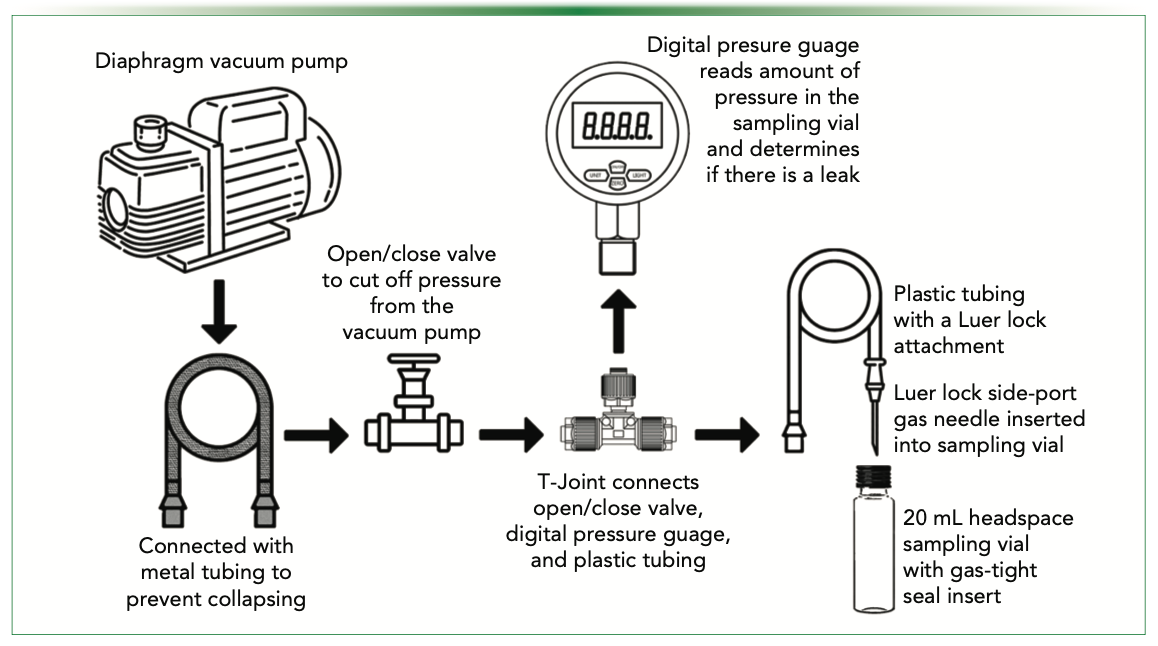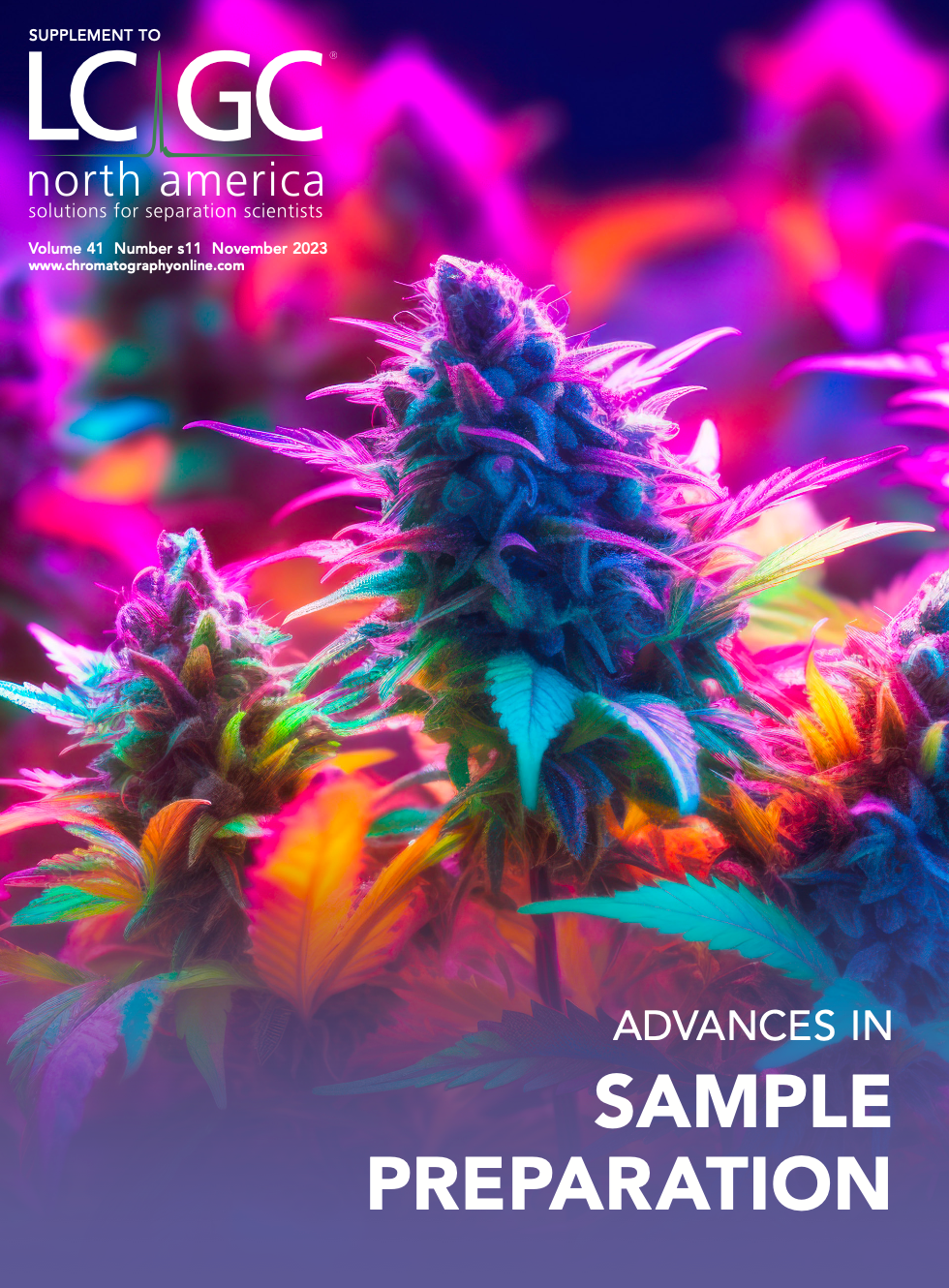Vacuum-Assisted Headspace Solid-Phase Microextraction Sampling Method for the Extraction of Semi-Volatile Compounds: An Overview
Vacuum-assisted headspace solid-phase microextraction (Vac-HS-SPME) is an emerging sampling technique that enhances the extraction of semi-volatile compounds. The one extra step of pulling vacuum from the sampling vial pre-equilibrium increases the concentration of semi-volatiles in the headspace and allows for faster extraction times. This overview highlights the timeline, applications, and fundamentals of Vac-HS-SPME.
Microextraction is an analytical extraction technique where the volume of the extraction phase is substantially smaller than the volume of the sample to be extracted. Because very small amounts of chemical compounds are extracted during sampling, microextraction allows multiple extractions of a sample with minimal change in the sample composition (1). Solid-phase microextraction (SPME) was pioneered by Janusz Pawliszyn in 1990 (2). This widely-used sampling technique was designed for fast and convenient sample preparation with greatly- reduced volumes of solvents applied. It also reduced needed sample volumes, sample handling, and extraction times. Traditional SPME uses a small-diameter fused silica fiber, coated with a small volume of extraction phase for the direct extraction of analytes from a sample. Sampling is typically conducted by direct immersion (DI-SPME) in a liquid sample or by headspace extraction (HS-SPME). In DI-SPME, the fiber is placed directly in the sample and analytes are extracted from the sample matrix. In HS-SPME, the fiber is exposed to the gas phase above a sample, where analytes partition into the fiber phase until equilibrium is reached (3).
The extracted sample components in the fiber are most often sampled using thermal desorption in the injection port of a gas chromatograph (GC). For liquid chromatography (LC), introduction of extracted compounds can be achieved through solvent desorption (4). SPME sampling offers completely automated analysis for increased throughput using commercial autosampler systems and customary analytical instruments.
HS-SPME is used for the extraction of volatile analytes in the headspace. Partitioning equilibration times are dependent on analyte volatility, sample matrix, and the composition of the extraction phase. Due to semi-volatile analytes having a low affinity for the gas phase, equilibration times for semi-volatiles (higher boiling point, lower vapor pressure) are longer than for volatiles (lower boiling point, higher vapor pressure). In order to shorten the equilibration time and enrich the fraction of semi-volatiles available for sampling in the headspace, salt can be added to a liquid sample to disturb analyte hydration (5), and the sample can be heated or agitated (6). Higher temperatures are known to cause sample decomposition or the formation of by-products.
The drawbacks related with long equilibration times and high extraction temperatures to improve HS- SPME sampling of semi-volatile analytes brought about the development of vacuum-assisted HS-SPME. This method consists of an extra step where the pressure in the sample vial is reduced by applying a vacuum prior to equilibration for sampling. Reducing pressure in the sampling vial assists analytes with longer equilibration times under standard atmospheric pressure to increase their concentration in the headspace. For a deep dive into the theory behind vacuum-assisted (Vac) HS-SPME, Psillakis (7) provides an exhaustive tutorial for Vac-HS-SPME sampling with a focus on liquid samples, and Yiantzi and co-authors (5) give a detailed procedure for recovering PAHs from solid matrices. This article gives an overview of the development, applications, and fundamentals of Vac-HS-SPME sampling.
Timeline and Applications
Table I outlines the development and applications of Vac-HS-SPME. In 2001, Brunton and associates (8) reported benefits of reduced pressure HS-SPME sampling of food aroma volatiles from cooked and raw turkey breast. These positive effects were later confirmed by both Darrouzes and coauthors (9) and Groenewold and associates (10). In 2012, Psillakis and coauthors (11) reduced the pressure in the sampling headspace by evacuating the air from a sample container prior to introducing the sample. They presented the theoretical model for pressure dependence and coined the technique as Vac-HS-SPME. Studies using Vac-HS-SPME sampling for liquid samples have included extraction of polycyclic aromatic hydrocarbons (PAHs) from water samples (27), aromatic amines in water, aromatic compounds in mulberry juice, earthy-musty odor compounds in water, free fatty acids and phenols found in milk (15), haloanisoles in wine (19), and a temperature study with extra virgin olive oil (21). Researchers have also explored Vac-HS-SPME sampling for solid samples, such as PAHs from sand, BTEX from polluted soil, nicotine in hair and tobacco, terpenoids from frank-incense resins, butanoic acids in hard cheeses, greener sampling techniques for oil bearing source-rock analysis (24), volatiles from raw fish at subambient temperatures (23), analyzing terpenoids and cannabinoids in hemp inflorescences in one combined method (25), and comparing volatiles among psilocybin and non-psilocybin mushrooms (26).

Vac-HS-SPME Sampling
Vac-HS-SPME sampling involves the evacuation of a sample vial before equilibration for sampling and extraction. There are several things to consider when preparing a sample for extraction, including the type of vessel, how to create a gas-tight seal, the device used to pull vacuum, and the order of vial preparation, which is dependent on sample type.
Sample Containers
Vac-HS-SPME sampling requires a vessel, specifically one which has a gas-tight seal and maintains vacuum for at least 24 h, and, ultimately, a vial that is used for common autosamplers. Psillakis and associates (7) have explored variations of sample containers and seals. Starting with a 1000-mL gas-sampling bulb, this container maintained vacuum up to 150 min, but lacked the ability to be agitated (11). This led to investigating 500-mL and 1000-mL custom-made glass sample vessels (28). These samplers were difficult to heat evenly and awkward to use. Plus, the volume of headspace compared to sample volume reduced the amount of analyte extracted by the fiber. To reduce the headspace volume, a 22-mL container was made from a standard 20-mL headspace vial with the addition of two gas-tight ports capable of accommodating solid samples (5,28). This container still lacked the ability to be automated. Psillakis and coauthors (15,29) explored several versions of seals that would accommodate a standard 20-mL headspace vial. Now, a stainless-steel insert (created by Prof. Elefteria Psillakis, ExtraTech Analytical Solutions SMPC), combined with a Thermogreen LB-1 septum with half-hole (Supelco), can be placed in the vial opening of a 20-mL headspace vial to create a gas-tight seal and be used on a HS-SPME autosampler. This insert has been provided recently to researchers for Vac-HS-SPME studies, including measurements of volatiles and semi-volatiles in hemp (25) and in edible versus psychedelic mushrooms (26).
Evacuation Process
Once a gas-tight seal has been created, one must consider how to evacuate the vial. A gas-tight syringe can be used by hand (10,22). The drawback is the seal could be compromised for the number of times needed to remove the air from the vial. Also, the rate at which one pulls the syringe can be inconsistent and be cause for variability. This method is cost-effective and has the possibility to be automated. A more effective and commonly used approach is to use a vacuum pump. A typical setup, shown in Figure 1, would be a diaphragm vacuum pump (generating ultimate vacuum to approximately 7 mbar) connected via metal tubing to an open/close valve. The metal tubing prevents collapsing, and the open/close valve allows the shut-off pressure from the vacuum pump when desired. A digital pressure gauge can be used to determine the amount of vacuum in the sampling vial, as well as to detect any leaks via pressure decay. A T-joint can be used to connect a digital pressure gauge with tubing on both sides. The other side of the T-joint would connect to tubing with a Luer lock attachment for a Luer lock side-port gas needle.
FIGURE 1: Vac-HS-SPME sampling setup.

The steps to evacuate the prepared sampling vial are as follows. Turn on the vacuum pump. Insert the side-port gas needle through the septum of the sealed vial. Vacuum time will be dependent on the type of vacuum pump used and the size of the vial. This can be determined with the use of the attached pressure gauge. Remove the needle while the vacuum pump is still running to ensure maximum vacuum. Only use the open/ close valve before sample preparation to check for leaks and to verify vial pressure. The sample vial is now ready for equilibration and HS-SPME extraction.
Vial Preparation
When preparing a liquid sample, the liquid can be introduced before or after the air has been evacuated from the vial (14,27,29). If introduced before pulling vacuum, one needs to consider possible removal of some highly volatile compounds during the evacuation process. One could analyze the highly volatile first by performing traditional HS-SPME before pulling vacuum from the vial, then proceed with Vac-HS-SPME to sample the semi-volatiles, which have lower affinity for the headspace. When vacuum is pulled from the vial first, a syringe is used to introduce the liquid sample. Due to the reduced pressure in the vial, the liquid will be pulled quickly from the syringe and spray on the vial walls. Depending on the properties of the liquid sample, this order of vial preparation could cause variability.
Solid samples need to be placed in the vial prior to air evacuation unless a special device is made, such as those used by Ghiasvand and coauthors (18). Again, this means that highly volatile compounds could possibly be removed during evacuation. Steps can be made to ensure the least amount of volatile loss. A smaller vessel, such as a 20-mL headspace vial, requires less time to evacuate. If using a vacuum pump, one could attach a pressure gauge, as shown in Figure 1, to determine when evacuation is complete to minimize vacuum time and loss of volatiles. One could also freeze the sample immediately after placing it in the vial, as demonstrated by Capetti and associates (20). This would prevent the concentration of volatiles in the headspace and minimize volatile loss during vacuum.
Effects of Temperature and Extraction Time
Temperature is a key parameter used during HS-SPME sampling (3). At room temperature, volatiles will reach headspace equilibrium in a short amount of time. Semi-volatiles will require more time to reach equilibrium and will be at low concentrations in the headspace. Increased temperature speeds up equilibration time and increases the concentration of semi-volatiles. For Vac-HS-SPME, studies have shown that increased extraction temperatures reduced extraction efficiency of semi-volatile analytes (30). One explanation is that increased temperature increases the vapor pressure of analytes, thus increasing the total pressure in the sampling vial and minimizing the effects of Vac-HS-SPME (31). Thus, lower sampling temperatures can be used in Vac-HS-SPME to avoid sample degradation or unwanted by-products, and these conditions can be advantageous for increased extraction yield for many analytes.
Extraction times for semi-volatile analytes under atmospheric pressure take much longer than volatile analytes. It may take only a minute for volatiles to reach equilibrium compared to an hour or more for some semi-volatiles. Reducing the pressure in the sampling vial accelerates equilibration time and increases concentration of semi-volatiles in the headspace. This makes the overall extraction time shorter. Studies have commonly reported shorter extraction times for semi-volatile analytes, as much as half the time, for Vac-HS-SPME compared to traditional HS-SPME (9,15,19,26,27).
Conclusion
Vac-HS-SPME sampling is an advantageous sampling technique for the extraction of semi-volatile compounds. This method can be used for both liquid and solid samples. With the ability to extract at low temperatures, Vac-HS-SPME has the potential for many applications, which involve thermally labile compounds and samples that degrade with increased temperature. The progression of seals designed for standard 20-mL headspace vials, combined with the ability to pull vacuum with a gas-tight syringe, opens the door for this sampling method to be fully automated in the coming future.
Acknowledgments
The authors would like to thank Restek Corporation for research and research materials support.
References
(1) Jalili, V.; Barkhordari, A.; Ghiasvand, A. New Extraction Media in Microextraction Techniques. A Review of Reviews. Microchem. J. 2020, 153, 104386. DOI: 10.1016/j.microc.2019.104386
(2) Arthur, C. L.; Pawliszyn, J. Solid Phase Microextraction with Thermal Desorption Using Fused Silica Optical Fibers. Anal. Chem. 1990, 62 (19), 2145–2148. DOI: 10.1021/ac00218a019
(3) Pawliszyn, J. Theory of Solid-Phase Microextraction. J. Chromatogr. Sci. 2000, 38, 270–278. DOI: /10.1016/B978-0-12-416017-0.00002-4
(4) Chen, J.; Pawliszyn, J. B. Solid Phase Microextraction Coupled to High-Performance Liquid Chromatography. Anal. Chem. 1995, 67 (15), 2530–2533. DOI: 10.1021/ac00111a006
(5) Yiantzi, E.; Kalogerakis, N.; Psillakis, E. Vacuum-Assisted Headspace Solid Phase Microextraction of Polycyclic Aromatic Hydrocarbons in Solid Samples. Anal. Chim. Acta 2015, 890, 108–116. DOI: 10.1016/j.aca.2015.05.047
(6) Zhang, Z.; Pawliszyn, J. Headspace Solid-Phase Microextraction. Anal. Chem. 1993, 65 (11), 1843–1852. DOI: 10.1021/ac00062a008
(7) Psillakis, E. Vacuum-Assisted Headspace Solid-Phase Microextraction: A Tutorial Review. Anal. Chim. Acta 2017, 986, 12–24. DOI: 10.1016/j.aca.2017.06.033
(8) Brunton, N. P.; Cronin, D. A.; Monahan, F. J. The Effects of Temperature and Pressure on the Performance of Carboxen/PDMS Fibres during Solid Phase Microextraction (SPME) of Headspace Volatiles from Cooked and Raw Turkey Breast. Flavour Fragrance J. 2001, 16 (4), 294–302. DOI: 10.1002/ffj.1000
(9) Darrouzès, J.; Bueno, M.; Pécheyran, C.; Holeman, M.; Potin-Gautier, M. New Approach of Solid-Phase Microextraction Improving the Extraction Yield of Butyl and Phenyltin Compounds by Combining the Effects of Pressure and Type of Agitation. J. Chromatogr. A 2005, 1072 (1), 19–27. DOI: 10.1016/j.chroma.2005.02.026
(10) Groenewold, G. S.; Scott, J. R.; Rae, C. Recovery of Phosphonate Surface Contaminants from Glass Using a Simple Vacuum Extractor with a Solid-Phase Microextraction Fiber. Anal. Chim. Acta 2011, 697 (1–2), 38–47. DOI: 10.1016/j.aca.2011.04.034
(11) Psillakis, E.; Yiantzi, E.; Sanchez-Prado, L.; Kalogerakis, N. Vacuum-Assisted Headspace Solid Phase Microextraction: Improved Extraction of Semivolatiles by Non-Equilibrium Headspace Sampling under Reduced Pressure Conditions. Anal. Chim. Acta 2012, 742, 30–36. DOI: 10.1016/j.aca.2012.01.019
(12) Rubio, L.; Sanllorente, S.; Sarabia, L. A.; Ortiz, M. C. Optimization of a Headspace Solid-Phase Microextraction and Gas Chromatography/Mass Spectrometry Procedure for the Determination of Aromatic Amines in Water and in Polyamide Spoons. Chemom. Intell. Lab. Syst. 2014, 133, 121–135. DOI: 10.1016/j.chemolab.2014.01.013
(13) Lee, C.; Lee, Y.; Lee, J.-G.; Buglass, A. J. Development of a Reduced Pressure Headspace Solid-Phase Microextraction-Gas Chromatography/Mass Spectrometric (RpHSSPME-GC/MS) Method and Application to Aroma Analysis. Anal. Meth. 2015, 7 (16), 6504–6513. DOI: 10.1039/C5AY00980D
(14) Glykioti, M.-L.; Yiantzi, E.; Psillakis, E. Room Temperature Determination of Earthy-Musty Odor Compounds in Water Using Vacuum-Assisted Headspace Solid-Phase Microextraction. Anal. Meth. 2016, 8, 8065–8071. DOI: 10.1039/c6ay02210c
(15) Trujillo-Rodríguez, M. J.; Pino, V.; Psillakis, E.; Anderson, J. L.; Ayala, J. H.; Yiantzi, E.; Afonso, A. M. Vacuum-Assisted Headspace-Solid Phase Microextraction for Determining Volatile Free Fatty Acids and Phenols. Investigations on the Effect of Pressure on Competitive Adsorption Phenomena in a Multicomponent System. Anal. Chim. Acta 2017, 962, 41–51. DOI: 10.1016/j.aca.2017.01.056
(16) Orazbayeva, D.; Kenessov, B.; Psillakis, E.; Nassyrova, D.; Bektassov, M. Determination of Transformation Products of Unsymmetrical Dimethylahydrazine in Water Using Vacuum-Assisted Headspace Solid-Phase Microextraction. J. Chromatogr. 2018, 1555, 30–36. DOI: 10.1016/j.chroma.2018.04.048
(17) Ghiasvand, A.; Zarghami, F.; Beiranvand, M. Ultrasensitive Direct Determination of BTEX in Polluted Soils Using a Simple and Novel Pressure-Controlled Solid-Phase Microextraction Setup. J. Iran. Chem. So. 2018, 15 (5), 1051–1059. DOI: 10.1007/s13738-018-1302-6
(18) Ghiasvand, A.; Koonani, S.; Yazdankhah, F.; Farhadi, S. A Comparison Study on a Sulfonated Graphene-Polyaniline Nanocomposite Coated Fiber for Analysis of Nicotine in Solid Samples through the Traditional and Vacuum-Assisted HS-SPME. J. Pharm.Biomed. Anal. 2018, 149, 271–277. DOI: 10.1016/j.jpba.2017.11.020
(19) Vakinti, M.; Mela, S. M.; Fernández, E.; Psillakis, E. Room Temperature and Sensitive Determination of Haloanisoles in Wine Using Vacuum-Assisted Headspace Solid-Phase Microextraction. J. Chromatogr. A 2019, 1602, 142–149. DOI: 10.1016/j.chroma.2019.03.047
(20) Capetti, F.; Rubiolo, P.; Bicchi, C.; Marengo, A.; Sgorbini, B.; Cagliero, C. Exploiting the Versatility of Vacuum-Assisted Headspace Solid-Phase Microextraction in Combination with the Selectivity of Ionic Liquid-Based GC Stationary Phases to Discriminate Boswellia Spp. Resins through Their Volatile and Semivolatile Fractions. J. Sep. Sci. 2020, 43 (9–10), 1879–1889. DOI: 0.1002/jssc.202000084
(21) Mascrez, S.; Psillakis, E.; Purcaro, G. A Multifaceted Investigation on the Effect of Vacuum on the Headspace Solid-Phase Microextraction of Extra-Virgin Olive Oil. Anal. Chim. Acta 2020, 1103, 106–114.DOI: 10.1016/j.aca.2019.12.053
(22) Sýkora, M.; Vítová, E.; Jeleń, H. H. Application of Vacuum Solid-Phase Microextraction for the Analysis of Semi-Hard Cheese Volatiles. Eur. Food Res. Tech. 2020, 246 (3), 573–580. DOI: 10.1007/s00217-020-03426-x
(23) Delbecque, N.; Mascrez, S.; Psillakis, E.; Purcaro, G. Sub-Ambient Temperature Sampling of Fish Volatiles Using Vacuum-Assisted Headspace Solid Phase Microextraction: Theoretical Considerations and Proof of Concept. Anal. Chim.Acta 2021, 1192, 339365. DOI: 10.1016/j.aca.2021.339365
(24) Pollo, B. J.; Romero-Orejón, K. L.; Marsaioli, A. J.; Rosa, P. T. V.; Augusto, F. Vacuum-Assisted Headspace Solid-Phase Microextraction and Gas Chromatography Coupled to Mass Spectrometry Applied to Source Rock Analysis. Adv. Sample Prep. 2022, 1, 100001. DOI: 10.1016/j.sampre.2021.100001
(25) Capetti, F.; Rubiolo, P.; Mastellone, G.; Marengo, A.; Sgorbini, B.; Cagliero, C. A Sustainable Approach for the Reliable and Simultaneous Determination of Terpenoids and Cannabinoids in Hemp Inflorescences by Vacuum Assisted Headspace Solid-Phase Microextraction. Adv. Sample Prep. 2022, 2, 100014. DOI: 10.1016/j.sampre.2022.100014
(26) Thomas, S. L.; Myers, C.; Schug, K. A. Advances in Sample Preparation Comparison of Fragrance and Flavor Components in Non-Psilocybin and Psilocybin Mushrooms Using Vacuum-Assisted Headspace High-Capacity Solid-Phase Microextraction and Gas Chromatography – Mass Spectrometry. Adv. Sample Prep. 2023, 8, 100090. DOI: 10.1016/j.sampre.2023.100090
(27) Solomou, N.; Bicchi, C.; Sgorbini, B.; Psillakis, E. Vacuum-Assisted Headspace Sorptive Extraction: Theoretical Considerations and Proof-of-Concept Extraction of Polycyclic Aromatic Hydrocarbons from Water Samples. Anal. Chim. Acta 2020, 1096, 100–107. DOI: 10.1016/j.aca.2019.10.050
(28) Psillakis, E.; Mousouraki, A.; Yiantzi, E.; Kalogerakis, N. Effect of Henry’s Law Constant and Operating Parameters on Vacuum-Assisted Headspace Solid Phase Microextraction. J. Chromatogr. A 2012, 1244, 55–60. DOI: 10.1016/j.chroma.2012.05.006
(29) Yiantzi, E.; Kalogerakis, N.; Psillakis, E. Design and Testing of a New Sampler for Simplified Vacuum-Assisted Headspace Solid-Phase Microextraction. Anal. Chim. Acta 2016, 927, 46–54. DOI: 10.1016/j.aca.2016.05.001
(30) Psillakis, E.; Yiantzi, E.; Kalogerakis, N. Downsizing Vacuum-Assisted Headspace Solid Phase Microextraction. J. Chromatogr. A 2013, 1300, 119–126. DOI: 10.1016/j.chroma.2013.02.009
(31) Psillakis, E. The Effect of Vacuum: An Emerging Experimental Parameter to Consider during Headspace Microextraction Sampling. Anal. Bioanal. Chem. 2020, 412 (24), 5989–5997. DOI: 10.1007/s00216-020-02738-x
(32) Schmitz, K. S.; Pollo, B. J.; Romero-Orejón, K. L.; Marsaioli, A. J.; Rosa, P. T. V.; Augusto, F.; EPA, 8270 E; Yiantzi, E.; Kalogerakis, N.; Psillakis, E. E.; et al. Downloaded from https://Iwaponline.Com/Wqrj/Article-Pdf/35/3/541/232630/Wqrj0350541.Pdf by Guest. Analytica Chimica Acta 2019, 1103 (xxxx), 3807577. https://doi.org/10.1016/j.aca.2019.10.050.
Shannon L. Thomas and Kevin A. Schug are with the Department of Chemistry & Biochemistry at the University of Texas at Arlington, in Arlington, Texas. Direct correspondence to: kschug@uta.edu

Thermodynamic Insights into Organic Solvent Extraction for Chemical Analysis of Medical Devices
April 16th 2025A new study, published by a researcher from Chemical Characterization Solutions in Minnesota, explored a new approach for sample preparation for the chemical characterization of medical devices.

.png&w=3840&q=75)

.png&w=3840&q=75)



.png&w=3840&q=75)



.png&w=3840&q=75)




